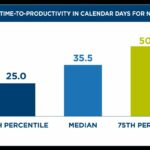As the winds of change relentlessly blow in the corporate arena, companies find themselves at a crossroads when it comes to managing workforce transitions. Outplacement, a strategic tool for supporting employee transitions during times of downsizing or restructuring, has long been a critical component of a compassionate and responsible approach to business. However, amidst the relentless pursuit of efficiency and cost-effectiveness, organizations are now seeking a path that aligns both empathy and fiscal prudence. Enter the era of predictive analytics for outplacement budgeting—a groundbreaking approach that combines data-driven insights with crystal ball-like prognostication. In this article, we delve into the realm of forecasting costs and benefits through the lens of predictive analytics, unraveling the enigma behind this innovative technique and shining a light on its potential to revolutionize the world of outplacement. So, fasten your seatbelts, and join us as we embark on a journey into the captivating world of predictive analytics for outplacement budgeting.
1. “Unlocking the Crystal Ball: The Evolution of Predictive Analytics in Outplacement Budgeting”
In the world of outplacement budgeting, the crystal ball of predictive analytics is shining brighter than ever before. This innovative methodology has revolutionized the way organizations make informed decisions about their workforce and financial planning, paving the way for smarter and more efficient strategies.
So, how exactly does predictive analytics work in outplacement budgeting? It starts by gathering vast amounts of data from various sources, such as employee performance records, market trends, and economic indicators. These data points are then subjected to sophisticated algorithms and machine learning techniques, which identify patterns, correlations, and trends that human analysts may overlook.
- Anticipating Future Talent Needs: Thanks to predictive analytics, organizations can now forecast their future talent needs with remarkable accuracy. By analyzing historical hiring patterns and turnover rates, they can identify potential talent gaps and proactively plan for them. This ensures a smooth and seamless transition during restructuring and streamlines the hiring process, reducing costs and minimizing disruptions.
- Optimizing Budget Allocation: Predictive analytics empowers organizations to optimize their outplacement budget allocation by pinpointing the areas that require the most resources. By assessing data on employee performance, skills, and potential, HR managers can categorize individuals into different risk categories. This helps them allocate resources strategically, focusing on individuals who are most likely to need assistance in finding new roles or transitioning careers.
2. “Peering into the Future: How Predictive Analytics is Revolutionizing Outplacement Cost Forecasting”
Predictive analytics has emerged as a game-changer in the realm of outplacement cost forecasting. With its ability to analyze vast amounts of data and generate accurate predictions, organizations can now better understand the financial implications of their workforce transitions. By harnessing the power of predictive analytics, companies can make informed decisions, optimize resources, and ultimately revolutionize their outplacement cost forecasting strategies.
So, how exactly does predictive analytics work its magic? The answer lies in the plethora of data points that can be analyzed. From historical employee data, market trends, economic indicators, to industry benchmarks – predictive analytics takes into account a multitude of factors to create a comprehensive forecast. By identifying patterns and trends, it enables organizations to estimate the costs associated with layoffs, retirements, and other workforce changes. This empowers decision-makers with valuable insights to proactively plan and budget with confidence.
- Predictive analytics provides accurate cost estimates for outplacement programs, allowing organizations to forecast expenses more effectively.
- By identifying potential workforce transitions, companies can take preemptive measures to mitigate costs and minimize disruption.
- Organizations can optimize their HR strategies and resources by aligning them with predicted outplacement needs.
With its ability to peer into the future, predictive analytics revolutionizes outplacement cost forecasting, paving the way for smarter workforce planning and a more efficient allocation of resources.
3. “Optimizing Investments: Harnessing Predictive Analytics to Forecast Outplacement Budget Costs and Benefits”
In today’s fast-paced business world, making informed decisions about investments is crucial for staying competitive. One area where predictive analytics can prove invaluable is in forecasting outplacement budget costs and benefits. By harnessing the power of data and predictive modeling, organizations can optimize their investments in outplacement programs, ensuring maximum return on investment and minimizing potential risks.
Here are some key benefits of using predictive analytics to forecast outplacement budget costs and benefits:
- Accurate cost estimation: Predictive analytics enables organizations to accurately estimate the costs associated with outplacement programs. By analyzing historical data, organizations can identify patterns and trends, allowing for precise budget allocation.
- Optimal resource allocation: With predictive analytics, organizations can identify the most effective strategies and resources for outplacement programs. This helps in optimizing resource allocation to achieve the best outcomes while minimizing unnecessary expenditures.
- Risk mitigation: By using predictive modeling, organizations can identify potential risks and challenges that may arise during the outplacement process. This enables proactive planning and implementation of contingency measures, reducing the potential negative impact on the budget and overall success of the program.
4. “Crystal Clear Insights: Leveraging Predictive Analytics for Smart Outplacement Budgeting Decisions
In today’s highly competitive job market, companies need to make every budgeting decision count when it comes to outplacement. That’s where predictive analytics comes in. By leveraging advanced data analysis and modeling techniques, organizations can gain crystal clear insights into the future of their workforce and make smart, informed decisions that minimize costs while maximizing employee outcomes.
With predictive analytics, companies can go beyond simple guesswork and tap into a wealth of historical data to identify trends and patterns that impact job transitions. By analyzing past layoffs, success rates, industry conditions, and employee skill sets, organizations can accurately predict the likelihood of workforce transitions and tailor their budgeting decisions accordingly. This enables smarter allocation of resources, ensuring that outplacement programs are targeted and effective, thereby reducing the financial burden on the company while also supporting displaced employees in finding new career opportunities.
In the dynamic landscape of corporate restructuring, predictive analytics emerges as a beacon of hope for organizations navigating the treacherous waters of outplacement budgeting. This groundbreaking tool has revolutionized how businesses allocate resources, allowing them to forecast costs and benefits with unparalleled precision.
As we draw the curtains on this illuminating exploration of predictive analytics for outplacement budgeting, we find ourselves on the threshold of a transformative era. Armed with artificial intelligence and advanced algorithms, organizations can now bid farewell to the traditional trial-and-error approach and embrace a more strategic and data-driven methodology.
Through the lens of predictive analytics, the complex web of variables that drive outplacement costs unravels before us. From labor market dynamics to employee skill sets and geographical factors, this powerful tool meticulously analyzes each thread, capturing invaluable insights into the future of workforce transition. With this newfound foresight, organizations can proactively plan and optimize their outplacement budgets, streamlining operations and enhancing overall efficiency.
Yet, predictive analytics offers more than just cost forecasting; it opens gates to the uncharted territory of benefits prediction. By harnessing the power of data, organizations can gauge the potential impact of outplacement initiatives on retention rates, employer brand, and the satisfaction of transitional employees. Armed with this knowledge, HR professionals can implement tailored strategies, bolstering internal morale and maintaining a positive external reputation.
Nevertheless, while predictive analytics offers immense promise, it does not replace the importance of human expertise. Rather, it complements it, empowering HR professionals with valuable indicators that guide decision-making. As organizations embark on their outplacement journeys, they must remember that predictive analytics is a tool, not the panacea. Strategic human judgment, fostered by years of experience, still remains the cornerstone of successful workforce transitions.
In conclusion, the integration of predictive analytics into the realm of outplacement budgeting marks a pivotal moment in the evolution of corporate restructuring. With its ability to forecast costs and benefits accurately, this transformative technology equips organizations with an unprecedented advantage in an ever-changing world. As businesses take a leap towards a future steeped in data-driven decision-making, the age of guesswork gradually fades into oblivion, giving way to a new era of strategic precision.
So, dear reader, as you bid adieu to this captivating exploration, let us each embrace the power of predictive analytics. Let us embrace the boundless possibilities it offers, arming ourselves with foresight and carving a path towards a brighter tomorrow in the realm of outplacement budgeting.








